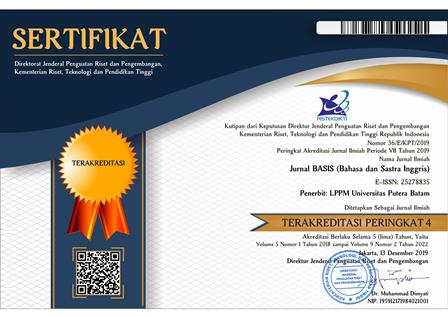RACE, MILIEU, AND MOMENT IN GONE WITH THE WIND BY MARGARET MITCHELL
DOI:
https://doi.org/10.33884/basisupb.v11i1.8180Keywords:
Historical approach, Racial Differences, SlaveryAbstract
Abstract
The purpose of creating this research is to reveal race, milieu, and moment in the novel “Gone with the Wind” written by Margaret Mitchell. In this research, researchers focused on applying historical approach by Hippolyte Adolphe Taine in Guerin et al. (2005) that consists race, milieu and moment to analyze “Gone with the Wind” novel as the data source. Besides applying the theory, descriptive qualitative research by Sugiyono (2012) was also applied by researchers due to the phenomena that were found in written form. To collect the data, researchers applied library research method by George (2008) by following four steps, they are: took “Gone with the Wind” novel as the data source, read the novel carefully, find the race, milieu, and moment, and collect and divide the data found. In analyzing the data, researchers focused on analyzing the extrinsic element explained by Wellek & Warren (1949) by applying race, milieu, and moment theory and presented them descriptively. For the findings, researcher found the race or racial differences on the skin color and their nationality in United States of America on North Georgia, in the Old South region. The milieu was discovered in the character’s occupation where they worked as businessman, plantation owner, breeding farm owner, student, farmer, soldier, maid, horse coachman, doctor, and prostitute. In addition, researchers also found the moment in the incident of Civil War and the slavery.
Keywords: Historical approach, Racial Differences, Slavery.
References
REFERENCES
Abbas, H. A. (2003). The Impact of War on David Malouf’s Novels: A Historical-Biographical Approach. Universiti Putera Malaysia.
Abdulqadr, K. S., Omer, R. J., & Sharif, R. H. (2021). Ezra Pound’s Poetry between Victorianism and Modernism: A Historical-Biographical Analysis. Technium Social Sciences Journal, 21, 826–832. https://doi.org/10.47577/tssj.v21i1.3817
George, M. W. (2008). The Elements of Library Research: What Every Student Needs to Know. Princeton University Press.
Guerin, W. L., Labor, E., Morgan, L., Reesman, J. C., & Willingham, J. R. (2005). A Handbook of Critical Approaches to Literature (Fifth Edit). Oxford University Press.
Hobson, A. (2004). Oxford Dictionary of Difficult Words (1st editio). Oxford University Press.
Mansoben, K. D. (2023). A Biographical Analysis Of William Blake’s Poems. Leksikon: Jurnal Pendidikan Bahasa, Sastra, Dan Budaya, 1(2), 1–17. Retrieved from https://ejurnal-unisap.ac.id/index.php/leksikon/article/view/101
Mitchell, M. (1936). Gone with the Wind (1st ed.). Simon and Schuster.
Roberts, E. V. (2007). Literature: An Introduction to Reading and Writing (Fourth Com). Pearson.
Sartika, I., & Arianto, T. (2022). Race, Milieu, And Moment In “Titanic” By James Cameron: Historical Approach. EScience Humanity Journal, 2(1), 47-52. https://doi.org/10.37296/esci.v2i1.18
Siahaan, M. I., & Satria, R. (2022). The Reflection of Social Class Conflict in “The Notebook” Novel by Sparks. Journal BASIS, 9(2), 204–212. https://doi.org/10.33884/basisupb.v9i2.5775
Sugiyono. (2012). Metode Penelitian Kuantitatif Kualitatif dan R&D (17th ed.). Alfabeta.
Wellek, R., & Warren, A. (1949). Theory of Literature. Jonathan Cape.













 JURNAL BASIS (BAHASA DAN SASTRA INGGRIS)
JURNAL BASIS (BAHASA DAN SASTRA INGGRIS)
